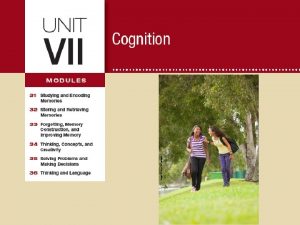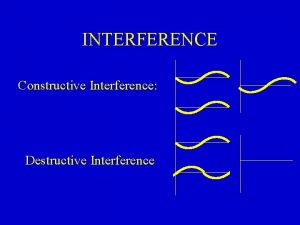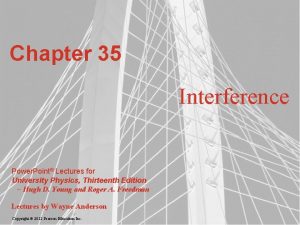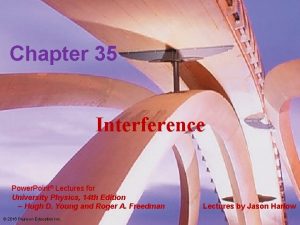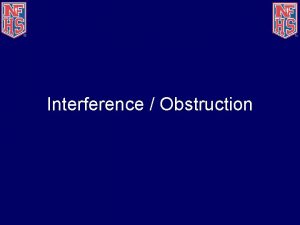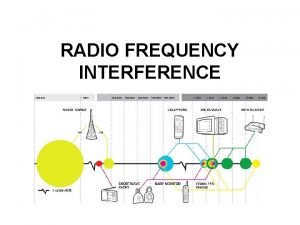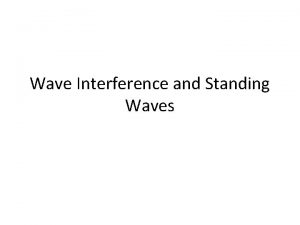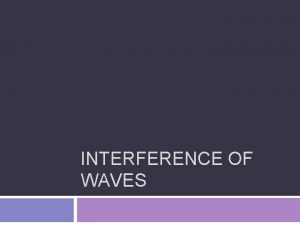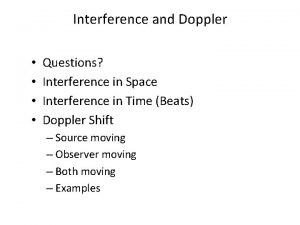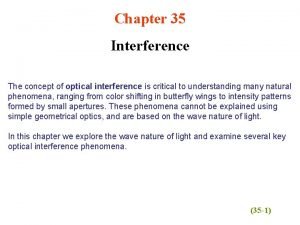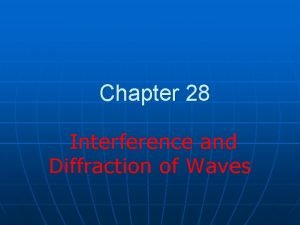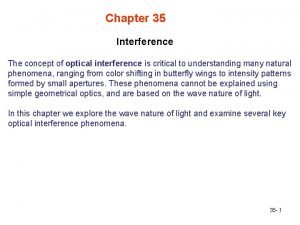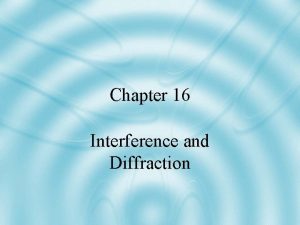Chapter 35 Interference Power Point Lectures for University

















- Slides: 17

Chapter 35 Interference Power. Point® Lectures for University Physics, Twelfth Edition – Hugh D. Young and Roger A. Freedman Lectures by James Pazun Copyright © 2008 Pearson Education Inc. , publishing as Pearson Addison-Wesley

Goals for Chapter 35 • To consider interference and coherent sources • To study two-source interference of light • To determine intensity in interference patterns • To consider interference in thin films • To study the Michelson interferometer Copyright © 2008 Pearson Education Inc. , publishing as Pearson Addison-Wesley

Introduction • Rainbows in the sky: been there, seen that. A thin-film soap bubble: why should that create a rainbow effect? • It seems we need to read Chapter 35 because the man on page 1207 has a large soap bubble and this thin film is dispersing white light and revealing a r. o. y. g. b. i. v. spectrum of color. Copyright © 2008 Pearson Education Inc. , publishing as Pearson Addison-Wesley

Wave fronts from a disturbance • Think back to our first slide on wave motion when the father threw an object into the pool and the boy watched the ripples proceed outward from the disturbance. We can begin our discussion of interference from just such a scenario, a coherent source and the waves from it that can add (constructively or destructively). • Consider Figure 35. 1. Copyright © 2008 Pearson Education Inc. , publishing as Pearson Addison-Wesley

A “snapshot” • The “snapshot” of sinusoidal waves spreading out from two coherent sources. • Consider Figure 35. 2. Copyright © 2008 Pearson Education Inc. , publishing as Pearson Addison-Wesley

Two-source interference of light • Figure 35. 4 shows two waves interfering constructively and destructively. • Young did a similar experiment with light. See below. Copyright © 2008 Pearson Education Inc. , publishing as Pearson Addison-Wesley

As the waves interfere, they produce fringes • Consider Figure 35. 6 below. Copyright © 2008 Pearson Education Inc. , publishing as Pearson Addison-Wesley

Interference from two slits or two radio stations • Follow Example 35. 1, illustrated by Figure 35. 7 (lower left). • Follow Example 35. 2, illustrated by Figure 35. 8 (lower right). Copyright © 2008 Pearson Education Inc. , publishing as Pearson Addison-Wesley

Intensity distribution • Figure 35. 10, below, displays the intensity distribution from two identical slits interfering. • Follow Example 35. 3. Copyright © 2008 Pearson Education Inc. , publishing as Pearson Addison-Wesley

Thin films will interfere • The reflections of the two surfaces in close proximity will interfere as they move from the film. • Figure 35. 11 at right displays an explanation and a photograph of thinfilm interference. Copyright © 2008 Pearson Education Inc. , publishing as Pearson Addison-Wesley

An air wedge between two glass plates • Just like thin film, two waves reflect back from the air wedge in close proximity, interfering as they go. Copyright © 2008 Pearson Education Inc. , publishing as Pearson Addison-Wesley

Interference between mechanical and EM waves • Figure 35. 13 compares the interference of mechanical and EM waves. Copyright © 2008 Pearson Education Inc. , publishing as Pearson Addison-Wesley

Thick films and thin films behave differently • Refer to Figure 35. 14 in the middle of this slide. • Read Problem-Solving Strategy 35. 1. • Follow Example 35. 4, illustrated by Figure 35. 15 at the bottom of the slide. Copyright © 2008 Pearson Education Inc. , publishing as Pearson Addison-Wesley

Thin-film examples • Consider Example 35. 5. • Consider Example 35. 6, illustrated by Figure 35. 16 shown below. Copyright © 2008 Pearson Education Inc. , publishing as Pearson Addison-Wesley

Newton’s rings • Figure 35. 17 illustrates the interference rings resulting from an air film under a glass item. Copyright © 2008 Pearson Education Inc. , publishing as Pearson Addison-Wesley

Using fringes to test quality control • An optical flat will only display even, concentric rings if the optic is perfectly ground. • Follow Example 35. 7. Copyright © 2008 Pearson Education Inc. , publishing as Pearson Addison-Wesley

Michelson and Morley’s interferometer • In this amazing experiment at Case Western Reserve, Michelson and Morley suspended their interferometer on a huge slab of sandstone on a pool of mercury (very stable, easily moved). As they rotated the slab, movement of the earth could have added in one direction and subtracted in another, changing interference fringes each time the device was turned a different direction. They did not change. This was an early proof of the invariance of the speed of light. Copyright © 2008 Pearson Education Inc. , publishing as Pearson Addison-Wesley
 Proactive interference
Proactive interference Retroactive interference
Retroactive interference Power system lectures
Power system lectures Power triangle
Power triangle Power bi power point
Power bi power point Point point power
Point point power Rick trebino lectures
Rick trebino lectures Lectures paediatrics
Lectures paediatrics Data mining lectures
Data mining lectures Advanced medicinal chemistry
Advanced medicinal chemistry Uva orthopaedics
Uva orthopaedics Ludic space
Ludic space Activity based approach in software project management
Activity based approach in software project management Molecular biology lecture
Molecular biology lecture Radio astronomy lectures
Radio astronomy lectures Dr sohail lectures
Dr sohail lectures Utilities and energy lecture
Utilities and energy lecture Web engineering lectures ppt
Web engineering lectures ppt

